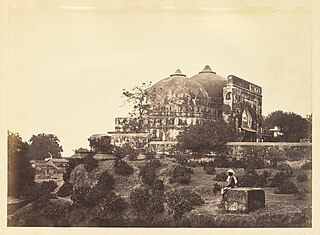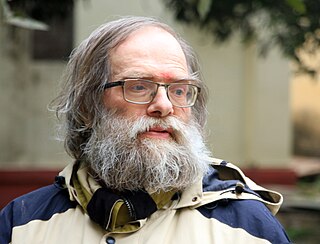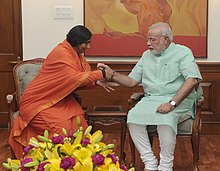
Babri Masjid was a mosque in Ayodhya, India. It has been claimed to have been built upon the site of Ram Janmabhoomi, the legendary birthplace of Rama, a principal deity of Hinduism. It has been a focus of dispute between the Hindu and Muslim communities since the 19th century. According to the mosque's inscriptions, it was built in 1528–29 by Mir Baqi, a commander of the Mughal emperor Babur. Before the 1940s, the masjid was officially known as "Masjid-i-Janmasthan". The mosque was attacked and demolished by a Hindu nationalist mob in 1992, which ignited communal violence across the Indian subcontinent.

Swami Chinmayananda Saraswati, born Balakrishna Menon; 8 May 1916 – 3 August 1993, was a Hindu spiritual leader and a teacher. In 1951, he founded Chinmaya Mission, a worldwide nonprofit organisation, in order to spread the knowledge of Advaita Vedanta, the Bhagavad Gita, the Upanishads, and other ancient Hindu scriptures. Through the Mission, Chinmayananda spearheaded a global Hindu spiritual and cultural renaissance that popularised these spiritual texts and values, teaching them in English all across India and abroad.

Koenraad Elst is a Flemish author, known primarily for his adherence to the Hindutva ideology and support of the Out of India theory, which is universally regarded as pseudo-historical by mainstream scholarship. Scholars accuse him of harboring Islamophobia.

Bajrang Dal is a Hindu nationalist militant organisation that forms the youth wing of the Vishva Hindu Parishad (VHP). It is a member of the right-wing Sangh Parivar. The ideology of the organisation is based on Hindutva. It was founded on 1 October 1984 in Uttar Pradesh, and began spreading more in the 2010s throughout India, although its most significant base remains the northern and central portions of the country.
The Sangh Parivar refers, as an umbrella term, to the collection of Hindutva organisations spawned by the Rashtriya Swayamsevak Sangh (RSS), which remain affiliated to it. These include the political party Bharatiya Janata Party, religious organisation Vishva Hindu Parishad, students union Akhil Bharatiya Vidyarthi Parishad (ABVP), religious militant organisation Bajrang Dal that forms the youth wing of the Vishva Hindu Parishad (VHP), and the worker's union Bharatiya Kisan Sangh. It is also often taken to include allied organisations such as the Shiv Sena, which share the ideology of the RSS.

Uma Bharti is an Indian politician and former Chief Minister of Madhya Pradesh. She became involved with the Bharatiya Janata Party at a young age, unsuccessfully contesting her first parliamentary elections in 1984. In 1989, she successfully contested the Khajuraho seat, and retained it in elections conducted in 1991, 1996 and 1998. In 1999, she switched constituencies and won the Bhopal seat.
The Liberhan Commission was a long-running inquiry commissioned by the Government of India to investigate the destruction of the disputed structure Babri Masjid in Ayodhya in 1992. Led by retired High Court Judge M. S. Liberhan, it was formed on 16 December 1992 by an order of the Indian Home Union Ministry after the demolition of the Babri Masjid in Ayodhya on 6 December and the subsequent riots there. The commission was originally mandated to submit its report within three months. Extensions were given 48 times, and after a delay of 17 years, the one-man commission submitted the report to Prime Minister Manmohan Singh on 30 June 2009. In November 2009, a day after a newspaper published the allegedly leaked contents of the report, the report was tabled in Parliament by the Home Minister P. Chidambaram.

Ashok Singhal was the international working president of the Hindu organisation Vishva Hindu Parishad (VHP) for over 20 years and in charge of the Ayodhya Ram Janmabhoomi movement. He was replaced in the Vishva Hindu Parishad in December 2011 following a long bout of diminishing physical health. Succeeded by Praveen Togadia, Singhal suffered ill-health but was working till a month before his death.
Madhav Vittal Kamath was an Indian journalist and broadcasting executive, and the chairman of Prasar Bharati. He worked as the editor of The Sunday Times for two years from 1967 to 1969, as Washington correspondent for The Times of India from 1969 to 1978 and also as editor of The Illustrated Weekly of India. He had also written numerous books and was conferred with the Padma Bhushan award in 2004. He was born in a brahmin family
Voice of India (VOI) is a publishing house based in New Delhi, India, that specialises in Hindu nationalist books and serves as one of the most important tools in the development of Hindutva ideologies.

Jai Shri Ram is an expression in Indic languages, translating as "Glory to Lord Rama" or "Victory to Lord Rama". The proclamation has been used by Hindus as a symbol of adhering to Hindu faith, or for projection of varied faith-centered emotions.

Vishva Hindu Parishad (VHP) is an Indian right-wing Hindu organisation based on Hindu nationalism. The VHP was founded in 1964 by M. S. Golwalkar and S. S. Apte in collaboration with Swami Chinmayananda. Its stated objective is "to organise, consolidate the Hindu society and to serve and protect the Hindu Dharma". It was established to construct and renovate Hindu temples, and deal with matters of cow slaughter and religious conversion. The VHP is a member of the Sangh Parivar group, the family of Hindu nationalist organisations led by the RSS.

The demolition of the Babri Masjid was carried out on 6 December 1992 by a large group of activists of the Vishva Hindu Parishad and allied organisations. The 16th-century Babri Masjid in the city of Ayodhya, in Uttar Pradesh, India, had been the subject of a lengthy socio-political dispute, and was targeted after a political rally organised by Hindu nationalist organisations turned violent.
The Akhil Bharatiya Akhara ParishadABAP, one of the organizations of Hindu sants (saints) and sadhus (ascetics) in India. The ABAP is composed of 14 akharas, or organisations of Hindu sants and sadhus. Nirmohi Akhara and Shri Dattatreya Akhara are two of the prominent akharas which are part of it.

The Ram Rath Yatra was a political and religious rally that lasted from September to October 1990. It was organised by the Bharatiya Janata Party (BJP) and its Hindu nationalist affiliates, and led by the then-president of the BJP, L. K. Advani. The purpose of the yatra was to support the agitation, led by the Vishwa Hindu Parishad (VHP) and its affiliates in the Sangh Parivar, to erect a temple to the Hindu deity Rama on the site of the Babri Masjid.

Ram ke Naam is a 1992 documentary by Indian filmmaker Anand Patwardhan. The film explores the campaign waged by the right-wing Hindu nationalist organisation Vishva Hindu Parishad to build a temple to the Hindu deity Ram at the site of the Babri Masjid in Ayodhya, as well as the communal violence that it triggered. A couple of months after Ram ke Naam was released, activists of the VHP and other Hindu nationalist groups demolished the Babri Masjid in 1992, provoking further violence. The film earned Patwardhan a wide recognition, and received several national and international awards.
Dhaneshwar Mandal is a retired Professor in Ancient History, Culture and Archaeology at Allahabad University. He is widely known for his strong position against the excavations at the Babri Masjid site in Ayodhya conducted by the Archaeological Survey of India.
Ghar Wapsi is the programme of religious conversion to Hinduism from Islam, Christianity, and other religions in India conducted by Indian Hindu nationalist organisations Vishva Hindu Parishad (VHP), Rashtriya Swayamsevak Sangh (RSS) and their allies. The term owes to the Hindu nationalist ideology that all people of India are ancestrally Hindu and, hence, conversion to Hinduism is one of "returning home" to their ancestral roots.
Vishnu Hari Dalmia was a noted Indian industrialist and a prominent member of Vishwa Hindu Parishad.
In October 1990, there was a major communal riot in Bijnor, a town in the state of Uttar Pradesh, India. Stemming from a celebratory procession by local Hindu groups, it was the most destructive riot in the wake of concurrent Hindu nationalist campaigns, which eventually led to the demolition of Babri Masjid. The riots were also characterized by phases of passive and active complicity of the state machinery.










